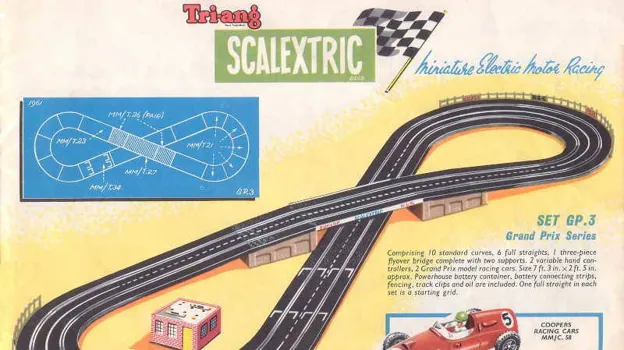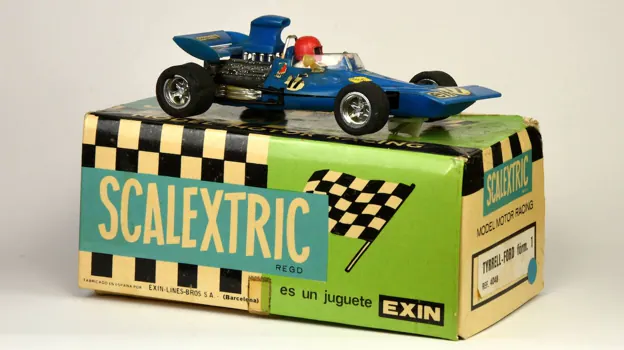The dream had come true. The protagonist of this story is one of the thousands of anonymous children who one day encountered a Scalextric. Or that of others not so anonymous like Carlos Sainz (two-time world rally champion and triple winner of the Dakar) who saw born his hobby on those circuits of small electric cars.
The Scalextric brand has had a troubled history being owned by or involved with several other famous companies and brands. But we are going to focus on its origins, which take us to Great Britain.
In October 1919, Bertram “Fred” Francis was born in Hampstead. He was not a good student, but after leaving school at fourteen, he showed great enthusiasm for engineering and a keen business mind. Thus in 1939, he founded a tool manufacturing company, Francis & Co. We are in the middle of World War II and he works day and night in the small premises located in Mill Hill, London.
After the war, in 1947, Francis decided to fulfill a childhood ambition and become a toy manufacturer: he founded Minimodels Ltd. Launched in 1948, the 'Minitype' typewriter was the first toy manufactured by the newly founded company. And shortly after, it introduced a range of tin trucks, although many believe that it was a car called “Traffic Car” with automatic steering and reversing, which was manufactured before trucks. And in 1950 he launched two reproductions of record-breaking cars: the Railton-Mobil Special, driven by John Cobb, and Goldie Gardner's MG EX-135.
Advertising for Scalex and Startex, the prologue of Scalextric
PF
Startex and Scalex
In 1952, it presented two ranges of tin toys powered by clockwork, one called Startex and another called Scalex, which dispensed with the classic winding key. The Scalex ones worked by pressing the car down, then pulling it back on its fifth wheel (located at the bottom, slightly behind the right front wheel); This is how the engine was recharged, then you let go of the little car and it ran about three meters forward. Those from Startex worked on the same principle, but had a rope that, when pulled, charged the motor. Initially, the Scalex range consisted of reproductions of five real models: Jaguar XK120; Aston Martin DB2; Austin Healey 100M; MG TF; and a Ferrari 375, to which a Maserati 250 F and a Jaguar Mk I would later be added. And the Startex one started with a Sumbeam Alpine to which were later added the Jaguar and Austin Healey from Scalex but with the Startex drive system.
The Scalex range of cars were designed at a 1/32 scale for saloon cars, whilst the Formula 1 cars (the Ferrari and Maserati) were closer to 1/28 scale. Model accuracy and scale consistency are the origin of the “Scale” name, and the addition of the final “x” is not known for certain. There are those who relate this “X” to the method of winding the clockwork motor: “x” is the unknown or keyless nature of the motor.
The electric motor arrives
Fred Francis noticed that some of his customers were installing small electric motors in their tin models and placing them on electric tracks with rails not unlike those used by model trains of the time. So Francis soon replaced the clockwork motor in the Scalex range of cars with an electric one. But he didn't stop there, and added a guide under the car, and devised a track system with a channel into which said guide was inserted, thus keeping the cars on the circuit. A simple on/off button through a separate terminal box circulated the electricity that powered the engines of each car along the track through braids located on the guide.
The new brand name was called “Scalextric”: the additional “tric” came from “electric.” Thus, the Scalextric brand is defined as “the range of Scalex cars equipped with an electric motor.” It is said that Fred Francis attended the races at the Goodwood circuit and it was there that he became fascinated by the Maserati 250 and Ferrari 375. So the first The first scalextric tin cars were the two Italian Formula 1 single-seaters, which was later added by the beautiful British sports car Austin Healey 100/6.

Page from the British Scalextric catalogue, from the early sixties
PF
The first Scalextric set was presented at the Harrogate International Toy Fair in 1957, and a year later Fred Francis sold Minimodels, including Scalextric, to the Lines Brothers of Tri-ang.
Tri-ang continued to produce the tin Scalextric range in 1958 and 1959, but used Rovex (a firm it had acquired in 1951 to produce plastic trains cheaper than metal ones) to develop a new range of more profitable Scalextric models. . The idea became a reality in 1960, with cars using plastic bodies and a derivative of the popular Tri-ang X.03 engine used in model trains. The first cars were the Lotus 16, Vanwall, Jaguar and Aston Martin DBR1. In addition, Tri-ang introduced controls that allowed the speed of the cars to be controlled by pressing a button with the thumb.
In Spain
Fred Francis' invention would arrive in Spain after an agreement, in 1962, between the British firm Tri-ang and the Spanish firm Exin. At first, in Spain the transformers and tracks were manufactured under a British license (which, by the way, between 1962 and 1964 were made by Pirelli), while the cars and other components came from the United Kingdom. In those years, buying a car individually, that is, separately from the set or set of tracks, controls, banks and fences, meant paying between three hundred and four hundred pesetas, which was an almost prohibitive amount for the purchasing power of the Spanish average.

Copper F1 from 1965, manufactured in Spain by Exin from the Tri-ang mold
J. of G
As models from that time we can remember the Austin Healey, Mercedes SL, or the Cooper and Ferrari Formula 1 cars, which were the first cars manufactured in Spain by Exin from Tri-ang moulds. And then came the 600 TC, which were the first designed and manufactured by Exin. This Spanish firm would end up becoming the owner of the Scalextric until its bankruptcy in 1992, leaving behind a spectacular production, always presented in boxes beautifully illustrated by the artist Luis Bargalló.
Although modern times are not the subject of this space, it is possible to do a quick review of them. After the closure of Exin, Scalextric passed into the hands of the multinational Tyco. A few years later, the Spanish company Tecnitoys became the owner of the Scalextric and multiplied its sales between 2001 and 2005. The success led to the fact that at the end of 2006, the Planeta group, through its company specialized in venture capital Inversiones Hemisferio, purchased 25% of Tecnitoys. And along with Hemisferio, well-known names from the business world attended the capital increase, such as Tomás Fornesa (son of the former president of La Caixa), or Juan Rosell (father of the former president of the CEOE). But in 2009 sales fell dramatically: it is already known that financiers do not like Scalextric (their thing was always Monopoly) and Tecnitoys is forced to negotiate with banks to sell its assets.

Tyrrel F1 from 1975
PF
Currently, in Spain, Mexico and Russia, the Scale Competition Xtreme SL is sold by the Scalextric company, while for the rest of the world it is the English company Hornby Hobbies, which sells in Spain under the Superslot brand.
But ours is the story and to complete it, a final note, a recommendation: reading one of the most complete works worldwide on this more than game, “Scalextric, history and nostalgia”, carried out by a team led by Jesús Alonso Domingo from Valladolid, a work full of rigor and extraordinary passion. The same passion with which children and adults will continue to squeeze the small speed controls in their hands with the hope that the Scalextric cars will never stop running.
#Scalextric #dream #Twelfth #Night #born

